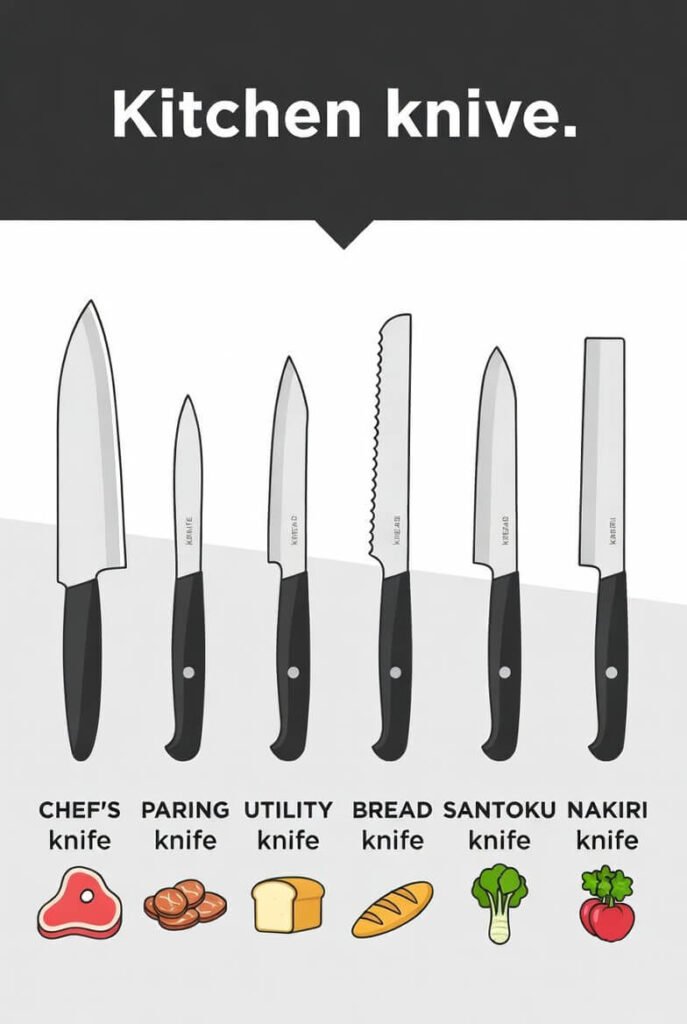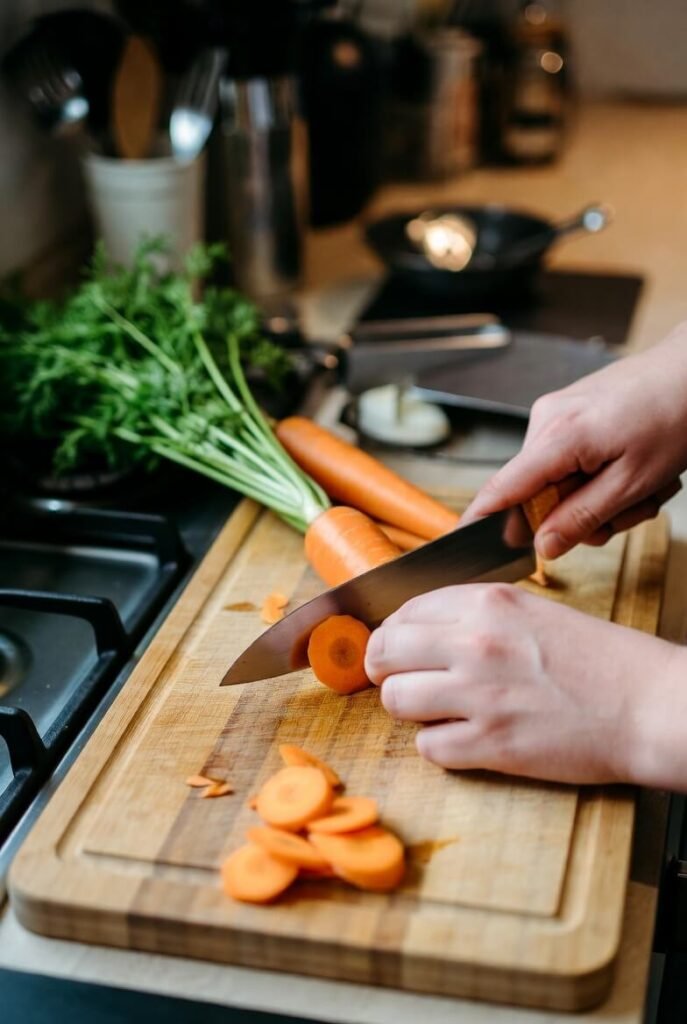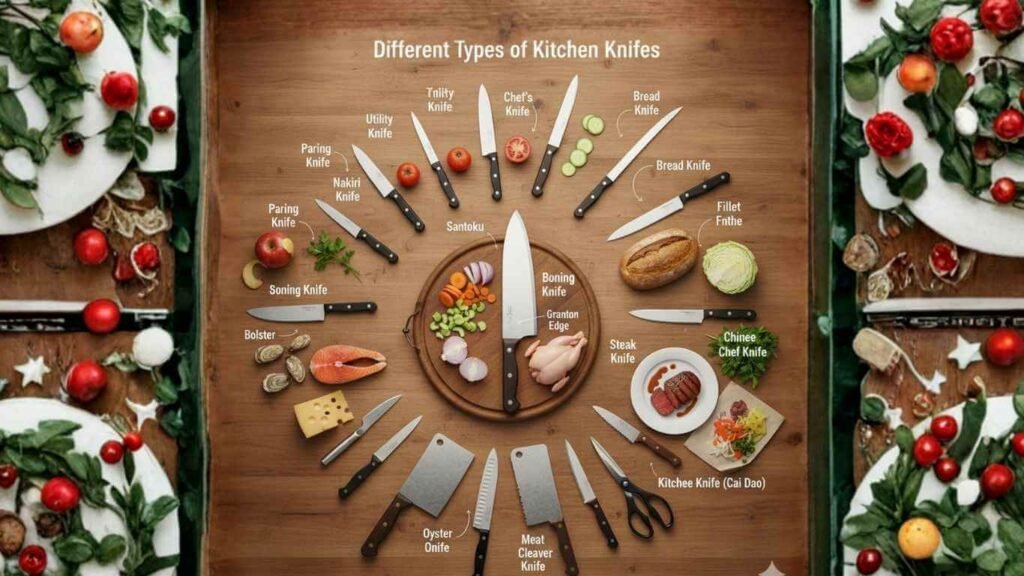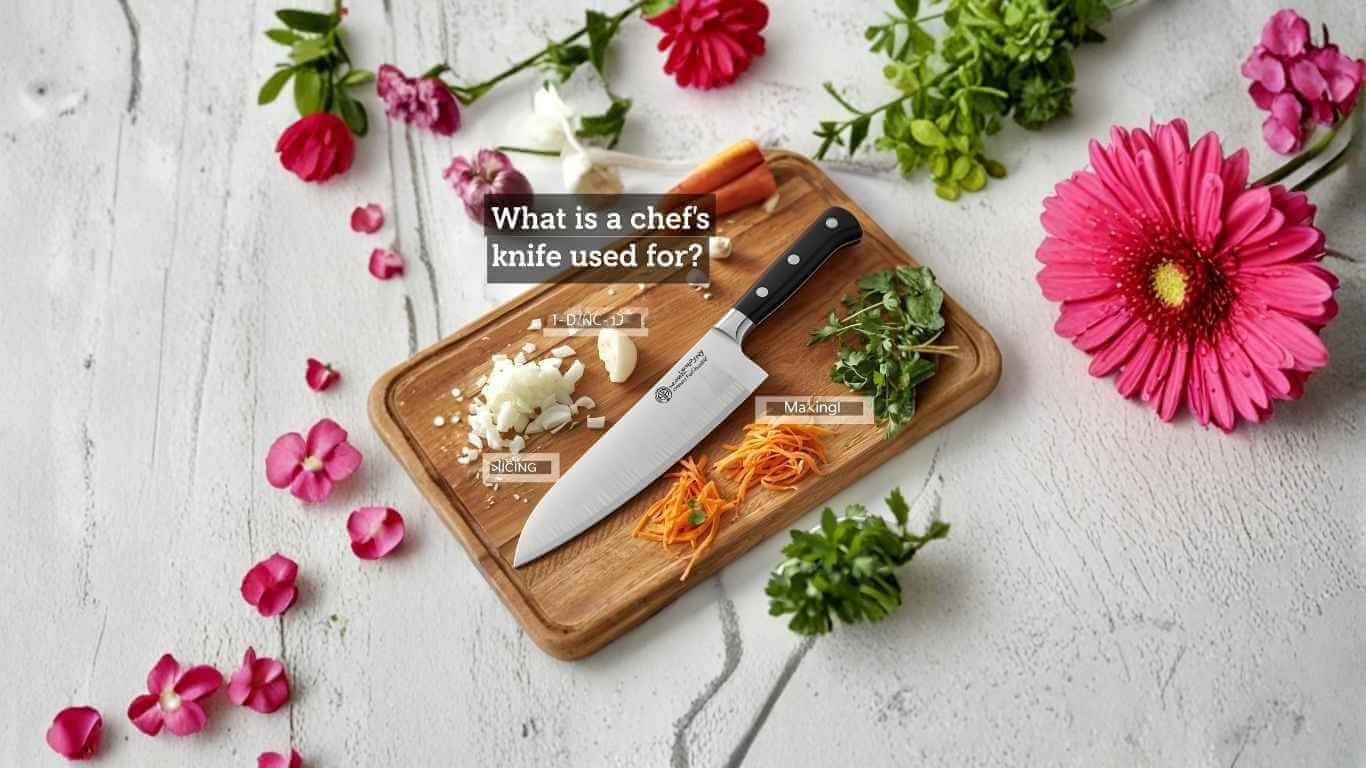A comprehensive guide to kitchen knives, focusing on the four most essential tools every home cook should own: the Chef’s Knife, Paring Knife, Utility Knife, and Serrated Bread Knife. With these four knives, you can handle 90% of common food-preparation tasks, from delicate vegetable slicing to cutting crusty bread.
Do You Need Different Types of Kitchen Knives?
Yes, absolutely. In spite of the fact that a talented home cook can accomplish a lot with just one Chef’s Knife, using a single tool for every task is inefficient, unsafe, and shortens the knife’s lifespan. Knives are designed specifically for different purposes.
Why Specialization Matters
- Safety: Using a small, sharp Paring Knife for peeling is much safer than trying to maneuver a large Chef’s Knife close to your hand.
- Efficiency & Precision: A Boning Knife, with its flexible, thin blade, removes meat from bones far cleaner and faster than a stiff Utility Knife.
- Blade Preservation: Cutting hard ingredients like squash or bones with a thin Slicing Knife can chip or dull the delicate edge. A sturdy Meat Cleaver is built to withstand such impact.
- Ergonomics: The handle shape and size of a knife are designed to fit the specific cutting motion required for a task, reducing hand strain during long kitchen tasks.
| User Type | Priority Knives | Key Kitchen Tasks Handled |
| New Home Cook | Chef’s, Paring, Bread | Chopping vegetables, peeling, slicing bread/tomatoes |
| Culinary Enthusiast | Boning, Santoku, Carving | Butchering chicken, fine dicing, carving roasts |
| Product Researcher | Nakiri, Yanagi, Cleaver | Testing specialized tasks, comparing performance, studying Japanese knives |

Essential Knife Types Every Home Chef Should Own
These are the indispensable workhorses found in professional and serious home kitchens. Understanding the blade shape, balance, and unique features of each is key to mastering your food prep.
1. The Chef’s Knife
The ultimate all-purpose kitchen knife. It is the most important investment you will make.
- Uses: Chopping, dicing, mincing, slicing. It handles almost all common kitchen tasks, from preparing herbs to breaking down whole vegetables. Learn more about what is a Chef’s Knife used for to master your main kitchen workhorse.
- Blade Shape: Features a broad, curved blade that tapers to a fine point. This curve facilitates the rocking-cutting motion preferred by most Western chefs.
- Unique Features: The bolster (the joint between the blade and handle) provides weight and protects your finger, while the wide heel is used for tough cuts.
- Food Pairings: Onions, carrots, celery, herbs, and large cuts of boneless meat.
- Pro Tip: Learn more about chef’s knife cutting techniques to maximize your speed and minimize fatigue.
2. The Paring Knife
The second most-used knife is essential for close-up, intricate work.
- Uses: Peeling, trimming, shaping, and precision cuts. Ideal for in-hand tasks. Discover what are paring knives used for in more detail, especially for intricate food prep.
- Blade Shape: A small, straight-edged blade, typically 2.5 to 4 inches long. The small size offers excellent control.
- Unique Features: Pointed tip for hulling strawberries and coring small fruits. Its straight edge is perfect for drawing clean lines.
- Food Pairings: Potatoes, apples, garlic, citrus, and delicate garnishes.
3. The Utility Knife
A versatile middle-ground knife, often filling the gap between the Chef’s Knife and the Paring Knife.
- Uses: Slicing sandwiches, trimming meat, cutting larger fruits and vegetables where a Paring Knife is too small, and a Chef’s Knife is too cumbersome.
- Blade Shape: Generally 5-7 inches long with a straighter edge than a Chef’s Knife. Some have a slight serration near the tip.
- Unique Features: Excellent for mid-sized precision cuts that don’t require the rocking motion.
4. The Bread Knife (Serrated)
Crucial for cutting soft items with hard exteriors without crushing them.
- Uses: Slicing bread, cakes, delicate pastries, and hard-skinned fruits like pineapple, tomatoes, and melons.
- Blade Shape: A long (8-10 inches) blade with a serrated edge (saw-like teeth).
- Unique Features: The teeth grab the hard crust and saw through the soft interior without applying downward pressure that would flatten the food.
- Food Pairings: Crusty sourdough, angel food cake, and ripe heirloom tomatoes.
Specialized & Regional Knives
Expanding your collection beyond the basics can significantly enhance specific areas of your cooking, especially if you explore the heritage of Japanese knives.
Santoku Knife (Japanese All-Purpose)
The Japanese answer to the Western Chef’s Knife. The name means “three virtues,” referring to its ability to cut fish, meat, and vegetables.
- Uses: Slicing, dicing, and mincing. It promotes the up-and-down chopping motion rather than the Western rocking motion.
- Blade Shape: Shorter (5-7 inches), flatter edge, and a distinctive rounded “sheep’s foot” tip.
- Unique Features: Many feature a Granton Edge (vertical dimples on the blade), which creates air pockets that prevent food from sticking.
Nakiri Knife (The Vegetable Specialist)
A dedicated vegetable knife from Japan, prized for its ability to make perfectly straight, thin slices.
- Uses: Push-cutting vegetables, creating paper-thin slices, and fine dicing.
- Blade Shape: Rectangular, flat-edged, and thin. It resembles a small, refined cleaver.
- Unique Features: Its totally flat profile is essential for achieving full contact with the cutting board, ensuring a clean cut all the way through without needing a forward or backward movement.
Boning Knife and Fillet Knife
Essential for processing meat and fish, especially for home chefs who buy whole cuts.
- Boning Knife: A medium, stiff, and narrow blade for removing raw meat from the bone.
- Fillet Knife: A long, very thin, and highly flexible blade for separating raw fish from skin and bone, often used for creating beautiful, even cuts of salmon.
Carving & Slicing Knives
Designed for presentation and efficiency when serving cooked meats.
- Uses: Making thin, uniform slices of cooked poultry, roasts, and ham.
- Blade Shape: Long (8-15 inches) and narrow, with a razor-sharp, straight edge. They are thinner than a Chef’s Knife to reduce drag.
- Unique Features: Often paired with a carving fork to hold the roast steady. Look for a Granton edge to help keep slices from sticking.
The Meat Cleaver
The brute force of the kitchen, designed for heavy-duty work, not finesse.
- Uses: Chopping through small, soft bones (like chicken or pork ribs) and separating frozen blocks of food. Also excellent for crushing garlic or picking up chopped ingredients.
- Blade Shape: A very large, heavy, rectangular blade.
Knife Materials & Blade Construction
A knife is only as good as the steel it’s made from and how it’s built. Understanding blade material and construction is critical for finding high-quality tools that last.
Comparison Table of Blade Materials
| Material | Pros | Cons | Best For | Heritage Notes |
| Stainless Steel | Very high rust resistance, easy to clean, durable | Harder to sharpen, edge dulls faster, softer edge | General use, budget-conscious home chef | Mass-produced knives, common utility items |
| High-Carbon Stainless | Combines rust resistance with edge retention/hardness, sharpens well | More expensive than basic stainless, requires moderate care | Serious home cook, all-purpose Chef’s Knives | The modern standard for premium European cutlery |
| Carbon Steel | Takes a razor-sharp edge, easiest to sharpen, holds edge the longest | Zero rust resistance (must be dried immediately), will stain/develop a patina | Experts, sushi chefs, cooks prioritizing extreme sharpness | Traditional European/Japanese knives, requires high maintenance |
| Honshu Steel (VG-10/SG2) | Exceptionally hard, retains edge for a very long time, aesthetic Damascus-style layering | Very brittle, prone to chipping if misused, most expensive | High-end Japanese knives (e.g., Santoku, Yanagi) | Direct Japanese swordmaking heritage, multi-layered steel core |
Anatomy: The Core of Quality
- Tang: The part of the blade that extends into the handle. A Full Tang extends the entire length of the handle, offering superior balance, strength, and durability—a hallmark of quality in a high-carbon stainless or carbon steel knife.
- Handle: Can be wood, composite, or plastic. It must be comfortable, non-slip, and securely fastened (riveted is best).
- Bolster: The thick collar between the handle and blade on forged knives. It adds weight for balance and acts as a safety guard.
- Heel: The rear-most corner of the blade’s cutting edge, used for heavy-duty, powerful cuts.
- Tip: The very end of the blade, crucial for fine, detailed work like scoring or piercing.
Blade Shapes & Edge Types Explained
The blade’s geometry dictates its optimal cutting techniques.
Blade Shape Profiles
- Curved/Rocking Profile (Chef’s Knife): The curved edge allows the knife to smoothly roll from the tip to the heel with the tip always in contact with the board, facilitating rapid, smooth mincing.
- Flat/Push Profile (Nakiri, Cleaver): A perfectly flat edge requires a straight up-and-down motion. This guarantees an even cut across the entire width of the food, essential for delicate Japanese knives like the Nakiri.
Edge Types
- Plain Edge: A smooth, continuous, sharp edge. Best for precision cuts where clean slicing is desired (Chef’s Knife, Paring Knife).
- Serrated Edge: Features a saw-like edge (Bread Knife). The peaks do the cutting, while the valleys protect the edge when cutting against a hard surface. Ideal for hard/crusty exteriors.
- Granton Edge (Hollow Ground): Features indentations or dimples along the side of the blade (common on Santoku and Slicing Knives). This creates air pockets to reduce friction and stop sticky foods (like raw potato or sliced cucumber) from clinging to the blade face.
How to Care for Your Kitchen Knives
Proper maintenance is the key to both safety and longevity. A dull knife is a dangerous knife.
- Honing vs. Sharpening:
- Honing: Realigns the knife’s edge (the very tip of the blade) that has rolled over from use. Do this frequently with a honing steel before or after every use.
- Sharpening: Removes metal to create a new, fresh edge. Do this less often (every few months to once a year) using a whetstone or professional sharpener.
- Safe Cleaning: Always hand-wash your quality knives immediately after use with warm water and a mild detergent. Dishwashers can damage the edge, corrode the blade material (especially carbon steel), and loosen the handle over time.
- Cutting Board Tips: Use only wood or high-quality plastic cutting boards. Never cut on glass, stone, or metal, as this will instantly destroy your fine edge.
- Storage: Use a magnetic strip, a dedicated knife block, or an in-drawer tray. Never store knives loose in a drawer, where they can dull against other utensils and pose a safety risk.

What About Other Knives?
For specialized kitchen tasks, there are countless niche tools:
- Steak Knives: Smaller, usually serrated knives for eating cooked meat at the table.
- Oyster Shuckers: Short, thick-bladed knives designed to pry open hard oyster shells safely.
- Cheese Knife: Often features holes (to prevent sticking) or a forked tip for serving. Learn why specific cheese knives are essential for soft cheese, and get expert tips on how to use cheese knives effectively.
- Chinese Chef’s Knife (Cai Dao): A thinner-bladed, all-purpose vegetable and meat cutter that acts as both a knife and a scoop.
- Yanagi Knives: Very long, single-beveled, thin-bladed Japanese knives used exclusively for slicing raw fish for sushi and sashimi.
FAQ Section (Featured Snippet Optimization)
What are the 4 types of kitchen knives?
The four essential types of kitchen knives every home chef should own are the Chef’s Knife (for general work), the Paring Knife (for precision/peeling), the Utility Knife (for mid-sized tasks), and the Serrated Bread Knife (for baked goods/delicate slicing).
What are the 8 basic types of knives and how are they used?
The eight basic knife types are: Chef’s Knife (all-purpose chopping), Paring Knife (peeling and trimming), Utility Knife (mid-sized slicing), Bread Knife (serrated slicing of soft items), Boning Knife (removing meat from bone), Slicing Knife (carving cooked roasts), Santoku Knife (Japanese all-purpose cutting), and the Meat Cleaver (heavy-duty chopping).
How do I choose the right kitchen knife for specific tasks?
Choose the right knife by matching the blade to the food and the task: use a Serrated Knife for soft interiors/hard exteriors (tomatoes, bread), a Nakiri for straight vegetable cuts, and a stiff, narrow Boning Knife for raw meat fabrication. Always prioritize control and the safety of the cut.
How to care for your kitchen knives?
To care for your knives, you must always hand-wash them immediately after use (never use a dishwasher), hone the edge frequently with a steel to keep it aligned, sharpen occasionally to maintain the edge, and store them securely in a block or on a magnetic strip to protect the cutting edge.
Conclusion: Select Your Edge
Selecting the right knives is a journey that ultimately depends on your personal cooking style and preferred kitchen tasks. Whether you gravitate toward the classic versatility of a German-style high-carbon stainless steel Chef’s Knife or the precision of a Honshu steel Santoku, prioritize a few high-quality knives over a large, low-quality set. By focusing on balance, blade material, and diligent maintenance, you will build topical authority in your own kitchen and elevate your food prep from a chore to a craft.



